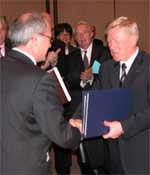
Image credit: ESA
Today in Moscow, ESA Director General, Jean-Jacques Dordain and the Head of the Russian Federal Space Agency, Anatoly Perminov signed an agreement for long-term cooperation and partnership in the development, implementation and use of launchers.
This agreement, which comes within the general framework of the Agreement between ESA and the Russian Federation for Cooperation and Partnership in the Exploration and Use of Outer Space for Peaceful Purposes, will strengthen cooperation between ESA and Russia, ESA?s first partner in the long-term cooperation on access to space.
ESA-Russian partnership is based on two main pillars: the exploitation of the Russian Soyuz launcher from Europe?s Spaceport in French Guiana and cooperation, without exchange of funds, on research and development in preparation for future launchers.
The Soyuz at Europe?s Spaceport programme covers the construction of the Soyuz launch facilities in French Guiana and the adaptations that Soyuz will need to enable it to be launched from French Guiana. A number of ESA Member States have signed up for this optional ESA programme and their contributions will be supplemented by a loan to Arianespace from the European Investment Bank, guaranteed by the French Government as a temporary measure pending the creation by the European Commission of a guarantee reserve mechanism. Complementary funding from the European Union is also envisaged.
Work to prepare the Spaceport for Soyuz is already underway in French Guiana as the first launch from Europe?s Spaceport is scheduled to take place in 2007.
Today?s agreement will also allow work to begin on the second pillar: preparation activities for the development of future space transport systems. Europe and the Russian Federation will collaborate in developing the technology needed for future launchers. Russian and European engineers will work together to develop reusable liquid engines, reusable liquid stages and experimental vehicles.
ESA?s aim is to have a new generation launcher ready by 2020.
Original Source: ESA News Release
